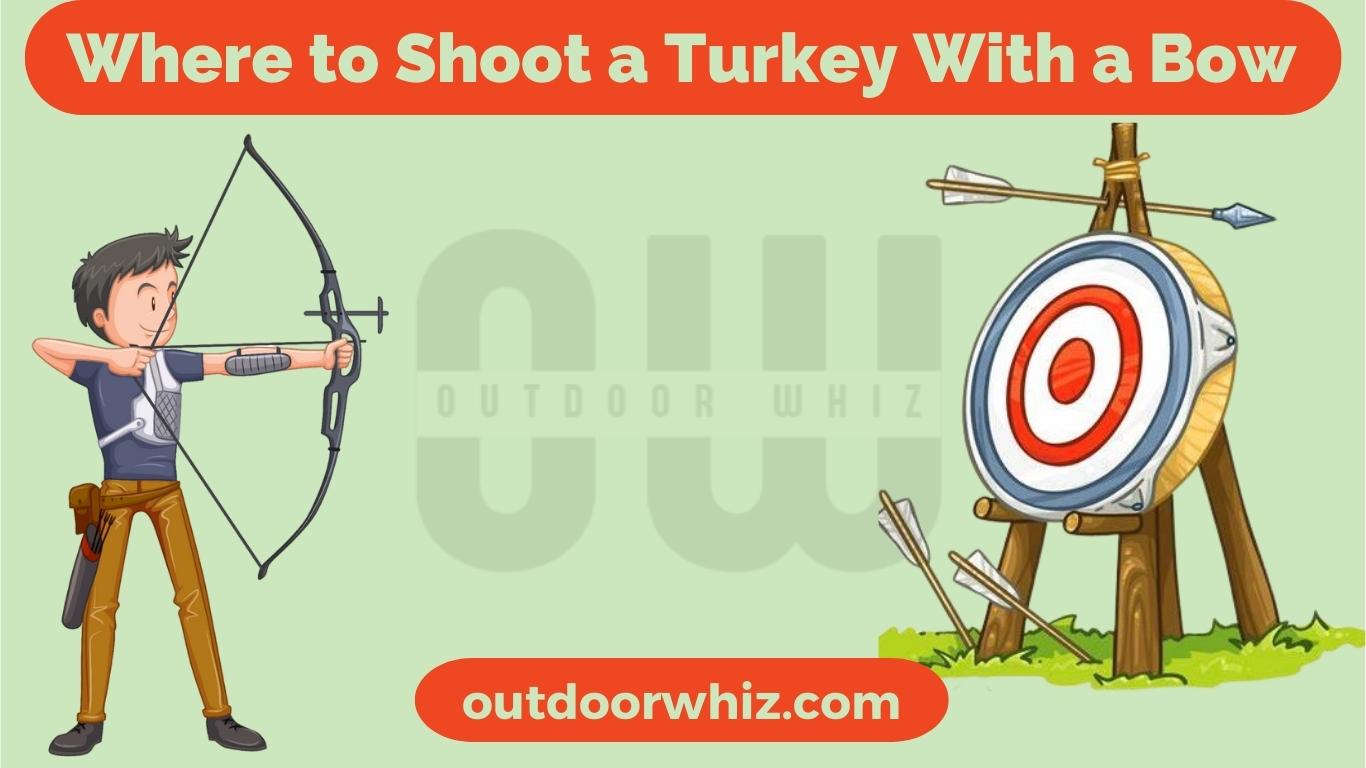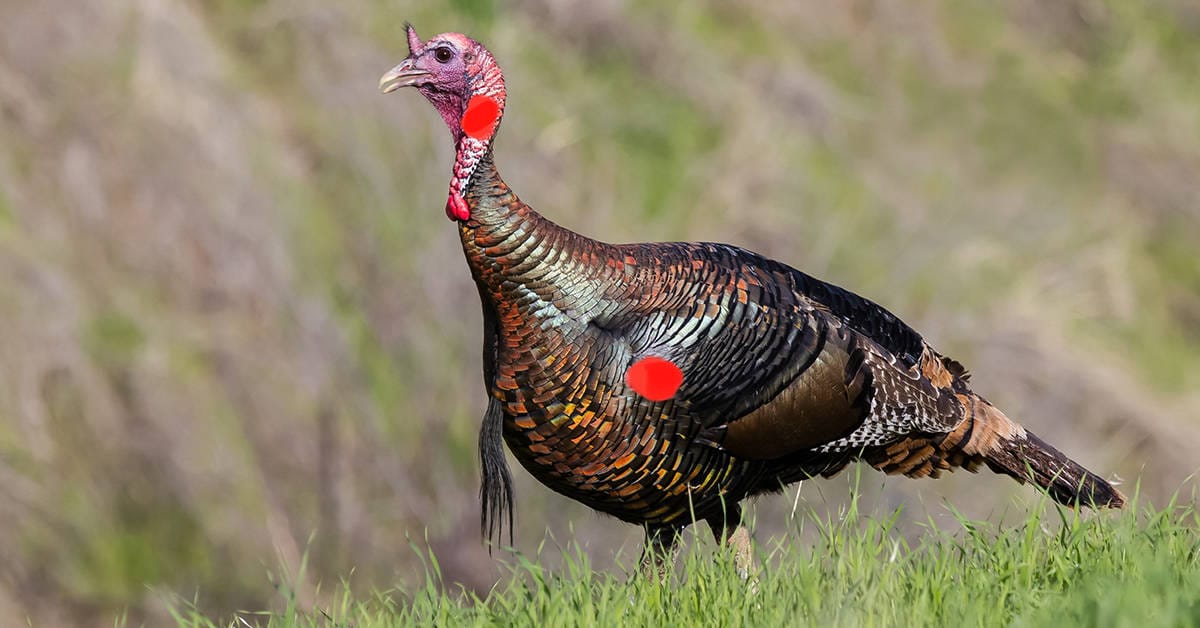Turkey hunting with a bow and arrow requires precision and knowing exactly where to place your shot Unlike using a shotgun, where you can target the head and neck area fairly easily, shooting a turkey with archery equipment demands an understanding of turkey anatomy and shot angles.
As responsible hunters, we owe it to the game we pursue to make ethical clean kills. Taking the time to learn proper shot placement will help ensure success when that big tom finally struts into range. In this guide, we’ll cover the turkey’s vital organs effective aiming points, shot angles, and best practices to ensure an effective harvest.
Turkey Vital Organs
A turkey’s vital organs sit higher and farther back than most hunters realize. The vital area, encompassing the heart and lungs, is only about the size of a softball. Hitting this small target requires accuracy and a clear understanding of the bird’s anatomy.
Heart: Located high in the midline of the chest cavity. About 2 inches wide.
Lungs: Stretch horizontally on either side of the spine, above the heart.
Spine: Runs down the midline of the back. Severing the spine will paralyze the turkey.
Head/Neck: Large but only fatal if severed. The neck sits lower than the vitals.
Effective Aiming Points
Where you aim depends largely on the turkey’s position and angle in relation to your stand. Here are the most effective aiming points for broadside, head-on, quartering, and rear shots:
Broadside
-
Strutting: Aim for the dark triangle where the wing meets the body. An inch behind the triangle will hit vitals.
-
Not strutting: Aim halfway up the body, in line with the legs. Focus on the spot where the wing feathers separate.
Head-on
- Aim just above the beard. If you hit slightly high, you’ll hit the neck. If low, the arrow passes through the beard into the chest cavity.
Quartering Toward
-
Strutting: Aim for the front edge of the dark triangle.
-
Not strutting: Follow the far leg up until even with the beard’s base. Shoot there.
Rear Shot
- Aim for the vent area at the base of the tail. Penetrates into the vitals.
Effective Shot Angles
While any broadside or rear shot will cause damage, some angles offer better opportunities for lethal shots. Here are the most effective shot scenarios:
-
Head-on – The beard makes an excellent sighting point. Frontal shots almost guarantee hitting vitals.
-
Broadside – A broadside strutting turkey presents a clear sight picture on the dark triangle.
-
Quartering Toward – Very lethal when you can see the far leg and beard as aiming points.
-
Rear Shot – The vent offers an easy reference point. Penetrates straight into vitals when centered.
Best Practices for Lethal Shots
Beyond anatomy and angles, some best practices will help you set up effective bow shots:
-
Use a blind to stay concealed when drawing your bow.
-
Employ decoys to distract toms and pull their focus.
-
Wait for birds to fully commit before taking a shot. Avoid rushing.
-
Pick expandable broadheads for higher accuracy and less deflection.
-
Aim for the dark triangle on a strutting bird’s side for identified vitals.
-
Let birds get close, within 20 yards, before shooting.
-
Remain calm and still to avoid detection when turkeys are near.
-
Be patient and allow turkeys to present the shot angle you are most comfortable with.
Key Takeaways
The most important points to remember when bowhunting turkeys:
-
Vitals sit high and back, about the size of a softball.
-
Leverage the beard as an aiming point whenever possible.
-
Sample effective aiming points include the dark triangle, base of the beard, and vent.
-
Prioritize broadside, head-on, and quartering toward shots for better penetration.
-
Avoid shots at a turkey’s neck or head only. Incomplete hits risk wounding.
-
Prepare with broadheads suited for turkeys and take time to calibrate your shots.
-
Allow birds to move into the most effective shooting lanes before drawing your bow.
With proper shot placement and patience, you’ll be able to make ethical, effective shots on turkeys with archery gear. Always put safety and lethal accuracy first when bowhunting. Follow these pointers and you’ll be ready when that old tom gobbles into view.

Aim Small, Miss Small
If you’re planning to archery hunt turkey for the first time, you probably want to know “where to shoot a turkey with a bow.” Wild turkeys have a very small vital area. This requires you to become an extremely proficient archer before pursuing them with a bow.
The old saying “aim small, miss small” has never been more descriptive of shooting wild turkeys with a bow. I always try to pick a feather or even a tiny dot on the turkey’s head as my aiming point. Again, a small miss is a lethal shot. If you simply shoot at a turkey, on the other hand, you’ll miss it altogether or wound it.
Over the years, I have found there are two main areas you can shoot a wild turkey to both kill and recover it. You can shoot them through the body, hitting bones and vital organs. Often, shooting them through their legs and wing bases will also hit the vital areas of the lungs and heart. Hitting them in these structural areas ensures the bird will not run or fly away, thus making recovery difficult. By aiming at this area, a slightly high shot will hit the spine, immobilizing the bird immediately. A slightly low shot will hit the hip joints, immobilizing the bird.
After shooting dozens of turkeys with a bow, my all-time favorite shot is the head shot. There is no room for error with the headshot; it’s either a clean kill or a clean miss.

Turkey Hunting with a Bow? Here Are 4 Shot Scenarios & Where to Aim
FAQ
Where should you shoot a turkey with a bow and arrow?
What is the best shot placement for a turkey?
Where is the best place to shoot a turkey with a broadhead?
How long to wait after shooting a turkey with a bow?
How do you shoot a Turkey with a bow?
They key is to call the bird in close, and to release your arrow while he’s relatively stationary. A turkeys movements are often erratic though so be warned, this is a challenging shot. A Turkey’s vitals are no bigger that an oversized softball, so shot placement is everything when hunting them with bows.
How do you shoot a Turkey Arrow?
A clean head/neck shot will produce devastating results. They key is to call the bird in close, and to release your arrow while he’s relatively stationary. A turkeys movements are often erratic though so be warned, this is a challenging shot.
What happens if you shoot a Turkey with an arrow?
This shot should break the bird’s wing, hit the spine, or hit the lungs or heart. However, if only the wing is broken, be prepared for a follow-up shot. Accuracy is key when shooting turkeys with an arrow in order for a successful hunt. 2. Quartering Shots
What is the best shot placement for a turkey hunter?
If you’re looking to be a successful turkey hunter, your best shot placement for bows and crossbows is the heart and lungs. Some turkey hunters prefer going for the neck and spine for quick kills, but it’s harder to make those shots successfully, especially with a strutting tom. 1. Broadside Shots
